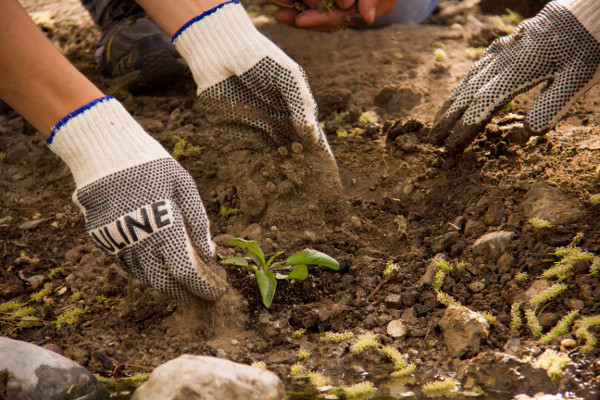
Planting greenery at the Desert National Wildlife Refuge. Photo by Jose Witt.
By Brian Beffort, Toiyabe Chapter Director
Spend time considering environmental issues, and you’ve probably thought about your environmental footprint—the sum total of all negative environmental impacts of the resources you consume and pollution you produce while living your life.
Numerous tools allow us to measure our various footprints:
- The Global Footprint Network has developed an Ecological Footprint tool that measures the ecological resources we consume, compared with nature’s ability to supply those resources and mange the waste we create;
- Conservation International and TerraPass have carbon footprint calculators to help us measure the carbon footprints of our lifestyles and activities;
- The Water Footprint Calculator helps us quantify and understand not only the water we draw from our taps, but also the water that’s required to produce the food we eat and the products we buy.
It can be intimidating, even depressing, learning the sourcing, connections, and impacts of our lifestyles extend. Once again, John Muir’s famous quote rings true, "When we try to pick out anything by itself, we find it hitched to everything else in the Universe."
But it can also be empowering, because it shows us how and where we can reduce our impacts.
What if we could empower ourselves even further, by measuring the good things we do for the world? This was an insight that inspired Greg Norris, codirector of the Sustainability and Health Initiative for Net-Positive Enterprise (SHINE) at the Harvard School for Public Health, and chief scientist at the International Living Future Institute.
As Norris writes, “Footprints are the negative consequences of all that it takes to sustain a person or an organization … the total planetary “cost” of your presence.
“Handprints represent the benefits of your presence: they’re the positive changes that you bring into the world ... If footprints are what we unavoidably take, handprints are what we intentionally give.”
Footprints move the needle into the red; handprints move it into the green. When you switch your incandescent lightbulbs for LEDs, you prevent future carbon dioxide and other pollutants from entering the atmosphere. When we compost our yard and food waste as a community, then use that mulch to grow local food, we are preventing valuable mulch from going into the landfill, while reducing the food-miles we consume. And when the good of our handprints offsets the impacts of our footprints, we are approaching sustainability.
We are challenged with the legacy and convenience of a chemical- and fossil fuel-based industrial economy. But slowly we are learning to replace our most toxic activities and products with more sustainable alternatives. It’s my dream that one day, we will live in a true cradle-to-cradle economy, in which every product and byproduct is nourishment for another cycle of products—just as in nature.
Until we get there, thinking about handprints, as Norris says, “is a wonderful opportunity to try and maximize the gifts that we give to the planet and to one another.”
So what is your handprint?
Read more about Norris and handprints here: